|
|
|
The railways in the Australian state of Victoria, a former British colony, were equipped with British-style semaphore signals from an early date.
Victorian Railways adopted the 'somersault' form of semaphore signal as standard c.1887. In contrast to Great Britain, where somersault signals usually worked to an almost vertical position when 'off' (see [2.36]), the arms in Victoria were inclined at an angle of 45°.
The arms of early distant signals were coloured red and, from c.1885, were fishtailed. The white marking on some of those arms was neither a stripe nor a chevron but rather a combination of the two, referred to as a 'reverse K' [VA.1 & VA.2].
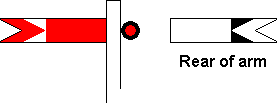 |
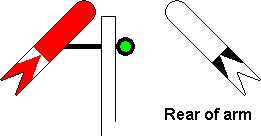 |
| [VA.1] Semaphore Distant Signal with 'reverse K' ('on'). | [VA.2] Semaphore Distant Signal with 'reverse K' ('off'). |
|---|
Yellow arms and lights on distant signals first appeared in Victoria at around the same time as in Great Britain (see [2.86]). The 'reverse K' gave way to a black chevron on the yellow arms. Red arms and lights continued to be used, however, where a distant arm was positioned below a stop arm [VA.3 - VA.5]. Use of a red light in this circumstance meant that two red lights were displayed at night when both arms were 'on' [VA.3]. If the upper light was to fail, the driver would see a single red light meaning 'danger', as opposed to a yellow light meaning 'caution'. The last example of a red distant arm was removed in 2005.
 |
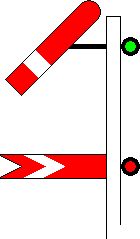 |
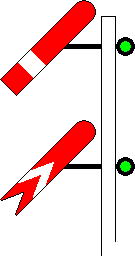 |
| [VA.3] Stop and Distant arms both 'on'. | [VA.4] Stop arm 'off', Distant arm 'on'. | [VA.5] Stop and Distant arms both 'off'. |
|---|
Calling-on signals consist of short somersault arms and show no light when 'on' [VA.6] or a yellow light when 'off' [VA.7]. Prior to 1954, the light was green rather than yellow.
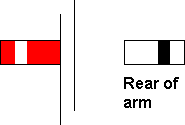 |
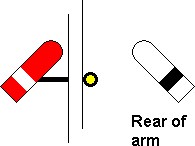 |
| [VA.6] Calling-on Signal ('on'). | [VA.7] Calling-on Signal ('off'). |
|---|
Shunting signals are mostly of the old-fashioned rotating disc type (see [4.1 & 4.2]). In Victoria, disc signals are rarely ground mounted and are normally elevated on posts. As in Britain, purple lights had at one time been used instead of red lights in some shunting signals.
Where points indicators are provided, these have square faces coloured half red and half green [VA.8 & VA.9]. The green half is visible on the side of the face corresponding to the direction that the train will take at the points. Early points indicators were equipped to display red and green lights side by side at night; later examples are reflectorised and have no lights.
 |
 |
| [VA.8] Points Indicator (Points set to left). | [VA.9] Points Indicator (Points set to right). |
|---|
North American three-position upper quadrant semaphore signals saw some use in Victoria. Unlike those that had once existed in Britain (see [2.82 - 2.84] and [2.91 - 2.93]), those in Victoria operated in conjunction with speed signalling principles, similar to American practice. Some signal posts were therefore provided with multiple arms or marker lights as required. Three-position shunting signals (see [4.49 - 4.51]) were used as well. By 2003, no three-position semaphore signals remained in Victoria.
The Train Protection & Warning System (TPWS) has been fitted on the Regional Fast Rail (RFR) network in Victoria, this being its first ever application outside the United Kingdom.
|